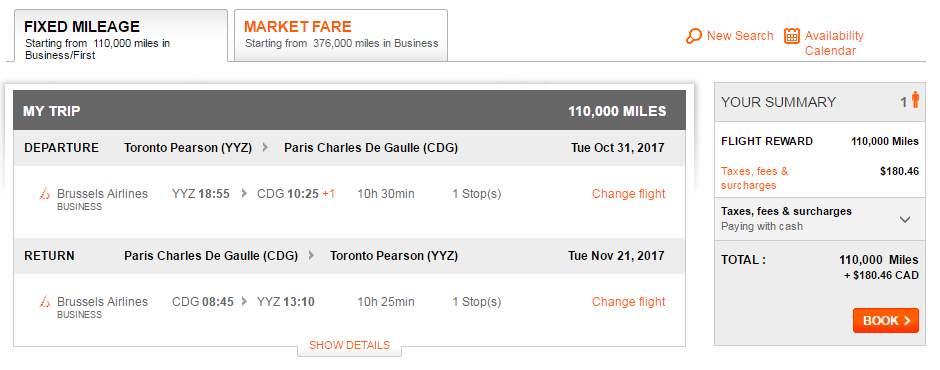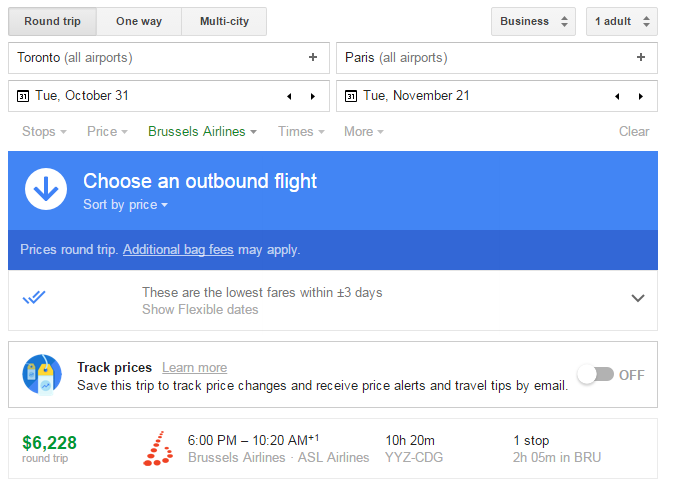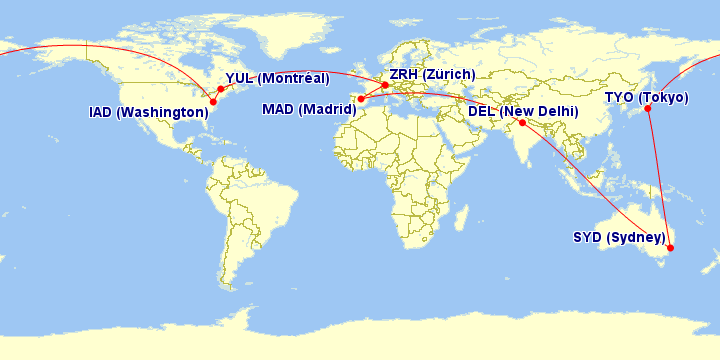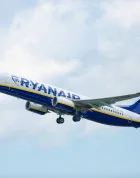In last week’s beginner three-step plan to redeeming miles for award flights, we discussed in detail two key practical components of any redemption – route research and award availability – before touching on the rather nebulous concept of “value”. We posed the question: how much value are you getting out of your points? Today, we’ll delve far deeper into the notion of value and look at how to properly calculate the return you’re getting for your points. We’ll also explore strategies to maximize value – in other words, to see more of the world for less.
The Value Proposition
Value is what makes points worth collecting. How many times have you heard someone remark, “why would I want points when I can just collect cash back?” Well, the best cash back cards in the market give you 2% back, maybe 4% for a promotional period. If you can consistently extract 3% value out of your points, then, you’re already doing better. As we touched on last time, by redeeming your points for premium flights, you can net upwards of 5%, 10% or even 15% return. That’s an incredible proposition for anyone, let alone you travel junkies out there!
Of course, points are only as valuable as what you redeem them for, so let’s figure out how to calculate the value received for a given redemption. The most commonly used metric is the below formula.
(Cash price - Taxes and fees) / Points used
Let’s look at the example from the previous post: a round-trip on Brussels Airlines from Toronto to Paris for 110,000 Aeroplan miles.

At the time of writing, purchasing this ticket outright with cash would cost $6,228:

Putting it all together, we have:
(Cash price – Taxes and fees) / Points used = (6228 - 180.46) / 110000 = 0.005497
That’s $0.055 per mile, or 5.50 cpm (cents per mile). If you had earned all of those 110,000 miles through credit card spending, this would be a very decent 5.5% return on your spending. Of course, it’s more likely that some portion of those miles were earned through signup bonuses, which complicates the math a little bit. But you get the basic idea.
Now keep in mind that this is a very simple metric. Some might argue that it’s even a bit disingenuous, since you could’ve and probably would’ve just have purchased economy tickets if you were forced to use cash rather than points. At the end of the day, however, let’s underscore a crucial point: value is subjective.
Sure, the higher the cpm the better, but if a redemption with a middling 2–3 cpm fits your needs perfectly and makes you satisfied, then it could offer the maximum value to you. Just make sure you arm yourself with information when making these judgments – you don’t want to redeem your miles for headphones or a toaster because you didn’t know how to use them for flights. (Since you’re reading this blog, that won’t be an issue!)
Of course, the next question comes all too naturally: what if we aren’t satisfied with 5.5cpm?
Stopovers: The Big Payoff
Let’s recap. We know that redeeming for business and first class flights can be a great value proposition. But a flight lasts a dozen hours at most, and once it’s over your hard-earned points are all spent.
So what’s the real payoff you travel lovers have been waiting for? What’s that extra factor that will transform miles and points from nice-to-have bonuses into insanely powerful, must-have tools to help you see the world?
One word: stopovers. The ability to visit multiple cities for the price of one.
A stopover on a flight itinerary is defined as a stop of more than 24 hours in a city between flights. (Notice there’s no upper bound; you can literally have a six-month stopover.) Compare that to the definition of a layover, which is a stop of up to 24 hours.
Aeroplan, the program we Canadians love to hate, allows you to book up to two stopovers in addition to your destination for no extra mileage. It’s the so-called “mini-round-the-world” trip.
What does that mean exactly? Say you’re based in Montreal and want to visit Australia. You have a month of travel time to work with. Instead of simply flying there and back, you could fly to Madrid, spend a week there… then fly to Sydney and stay for two weeks… then fly to Tokyo and spend yet another week there before flying home.

It doesn’t have to be those cities either. For the first stopover, you can substitute Madrid for anywhere in Europe, the Middle East, or even Africa (within certain reasonability limits). For the second, you could replace Tokyo with any city in Asia. You could even opt to have your stopover elsewhere in North America, perhaps to visit family on the west coast on your way back home. The possibilities are endless.
And if you’re lucky enough to have a longer period to work with – say, six months – you could conceivably spend two months on each continent, taking the time to explore as far afield as you’d like, all for the same number of miles as it would’ve cost to book a two-week round-trip ticket down under.
Heaven for travel lovers.
Booking the Behemoth
Of course, the more complex your trip, the more searching and strategizing is required to put it all together and actually book it.
The procedure is actually pretty simple. Follow Steps 1 and 2 from last time, but this time to do it segment by segment. In the above example, you’d do your route research and find availability for Montreal to Madrid first. Once you’ve found a routing you’re happy with, write down the dates and flight numbers, then move on to the Madrid to Sydney segment. Rinse and repeat for Sydney to Tokyo, then for Tokyo to Montreal. And remember, aim to avoid airlines that levy fuel surcharges!
Now, after a bit of careful searching and surcharge-dodging, you might have the following written down:
1. Swiss / LX87 / Montreal to Zurich / Sep 3 / 1800 0620+1 2. Swiss / LX2026 / Zurich to Madrid / Sep 4 / 1225 1445 3. Air India / AI136 / Madrid to New Delhi / Sep 11 / 2150 1105+1 4. Air India / AI302 / New Delhi to Sydney / Sep 12 / 1315 0710+1 5. ANA / NH880 / Sydney to Tokyo / Sep 26 / 2130 0505 6. ANA / NH2 / Tokyo to Washington / Oct 4 / 1040 1015 7. United / UA6032 / Washington to Montreal / Oct 4 / 1705 1843
As you can see, we have a few longish layovers, but those can easily become a fourth or fifth destination we can explore on this trip, in the form of a quick city break. Alternatively, if we redeem for a business class ticket, we’d be able to access the lounge and pass the time there.

Unfortunately, the Aeroplan search engine can’t handle a multi-city search with two stopovers, so you’ll have to call in. (If you only wanted one stopover, you could try the multi-city search option, but if it doesn’t show you your desired routing then you’ll have to call in anyway.) There’s an unavoidable fee of $30 plus tax, per person, for bookings made via the call centre, but it’s a small price to pay for the epic trip you’re about to book.
Once you’re connected to an agent, simply feed them the city pairs and flight numbers you’ve found. If you’ve done everything right, the agent should have no problem constructing the itinerary and issuing your ticket.
Conclusion
The example we’ve given in this post is the quintessential “mini-round-the-world” or “mini-RTW” redemption on Aeroplan. If booked in business or first class, it’s far and away the most valuable way to use your Aeroplan miles.
I understand that all this can definitely seem very intimidating to a beginner. I, for one, was overwhelmed by the volume of information out there when I first started out. If I were to end the Miles & Points Intro with some parting advice, it would be to take action – sure, following the travel blogs and forums is a good start, but you don’t start “getting” it until you’ve actually been in the game for a little while.
Too many people dream of visiting all sorts of amazing places for many years, but never find the courage or motivation to actually take the trip. Many others never bother to scale the very gentle learning curve of loyalty schemes such as Aeroplan, and then go on to decry these points programs as worthless. Don’t be one of these people! Learn how to make the programs work for you, and then put it all into action.















Hi!
Love your blog. I was wondering if you book first class will all of your flights be first class with multiple stopovers ?
Only if you find available space in First Class. Otherwise, you might have some flights in First Class and others in business.
Hi Ricky,
Thanks for all this information. I am trying to validate this trip. Can you please help or any suggestions how I could maximize this?
YYZ > TPE
TPE > SIN (Open-Jaw)
BKK > ICN
ICN > YYZ
Thanks
Looks like it should work fine, although if you have an open-jaw, then only one of TPE and ICN can be a stopover. If you’re interested in seeing other places in Asia, you can also try to fit in a few long layovers as well.
Hi Ricky, thanks for creating such an amazing blog with your wealth of knowledge! You mentioned that the possibilities for where we can choose our stopovers are endless. Are they truly? Do they have to be from one continent to another? Say, can you do a concentrated trip with 3 destinations (2 stopovers included) all WITHIN Asia? i.e. Toronto > Seoul > Tokyo > Taipei > Toronto
Thanks!
What you’ve described IS possible, but you are correct in that there are certain restrictions. For example, you can only have one stopover in addition to the destination if your trip is wholly within North America. In addition, certain trios of cities don’t necessarily work because of MPM issues.
When trying to book international trips such as this example, I have found that Aeroplan often doesn’t display the Star Alliance options other than AC flights. And when I call, the agents seem to be restricted to the choices that display online. Is there a way to find out about, and access Star Alliance options that do not display on the Aeroplan site?
Good Q!
What would you suggest dealing with the trip interruptions due to the road traffic problem unable returning to the airport on time after the layover?
Suggestion on Insurance?
Plan sufficient time to get to and from the airport. Research how far the airport is from the city centre and the major sightseeing points, and make sure you allot enough time for unexpected events.
For insurance, look for credit cards with trip interruption insurance. These usually cover you for when you miss your flight due to a motor vehicle accident you’re involved in, natural disasters, unexpected illness, etc.
For your example of Layovering at Cairo to see the Pyramids :
how usually you would budget the deplaning/boarding plus travelling time for the net touring time of the target sight(s)?
Then, and how about the luggage?
NYT Travel has some 36-hour guides; maybe we could have some layover guide for some destinations?
Hmm, maybe 3 hours minimum for all the immigration / baggage claim / travel to and from the airport. Then let’s say you need to sleep for 8 hours. That still leaves 12+ hours of exploration time in a city, which is plenty of time to decide whether or not you’d like to come back in the future.
For luggage, if you’re getting in early in the morning you can leave your stuff at the hotel before your room is ready. Same with if you’re checking out but your flight’s not till late in the evening: you can ask to leave your luggage there and most hotels will be more than happy to look after them for you.
Layover guides are a great idea! Thank you for the suggestion!